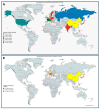Proton and Heavy Particle Intracranial Radiosurgery
- PMID: 33401613
- PMCID: PMC7823941
- DOI: 10.3390/biomedicines9010031
Proton and Heavy Particle Intracranial Radiosurgery
Abstract
Stereotactic radiosurgery (SRS) involves the delivery of a highly conformal ablative dose of radiation to both benign and malignant targets. This has traditionally been accomplished in a single fraction; however, fractionated approaches involving five or fewer treatments have been delivered for larger lesions, as well as lesions in close proximity to radiosensitive structures. The clinical utilization of SRS has overwhelmingly involved photon-based sources via dedicated radiosurgery platforms (e.g., Gamma Knife® and Cyberknife®) or specialized linear accelerators. While photon-based methods have been shown to be highly effective, advancements are sought for improved dose precision, treatment duration, and radiobiologic effect, among others, particularly in the setting of repeat irradiation. Particle-based techniques (e.g., protons and carbon ions) may improve many of these shortcomings. Specifically, the presence of a Bragg Peak with particle therapy at target depth allows for marked minimization of distal dose delivery, thus mitigating the risk of toxicity to organs at risk. Carbon ions also exhibit a higher linear energy transfer than photons and protons, allowing for greater relative biological effectiveness. While the data are limited, utilization of proton radiosurgery in the setting of brain metastases has been shown to demonstrate 1-year local control rates >90%, which are comparable to that of photon-based radiosurgery. Prospective studies are needed to further validate the safety and efficacy of this treatment modality. We aim to provide a comprehensive overview of clinical evidence in the use of particle therapy-based radiosurgery.
Keywords: ablative; arteriovenous malformation; carbon; particle; proton; radiation oncology; radiation therapy; radiosurgery; stereotactic; tumor.
Conflict of interest statement
The authors declare no conflict of interest.
Figures


Similar articles
-
Regarding: Rosenthal DI, Glatstein E. "We've Got a Treatment, but What's the Disease?" The Oncologist 1996;1.Oncologist. 1997;2(1):59-61. Oncologist. 1997. PMID: 10388030
-
Clinical and radiobiological advantages of single-dose stereotactic light-ion radiation therapy for large intracranial arteriovenous malformations. Technical note.J Neurosurg. 2009 Nov;111(5):919-26. doi: 10.3171/2007.10.17205. J Neurosurg. 2009. PMID: 19392591 Review.
-
Changing practice patterns of Gamma Knife versus linear accelerator-based stereotactic radiosurgery for brain metastases in the US.J Neurosurg. 2016 Apr;124(4):1018-24. doi: 10.3171/2015.4.JNS1573. Epub 2015 Oct 16. J Neurosurg. 2016. PMID: 26473783
-
Stereotactic radiosurgery versus stereotactic radiotherapy in the management of intracranial meningiomas: a systematic review and meta-analysis.Neurosurg Focus. 2019 Jun 1;46(6):E2. doi: 10.3171/2019.3.FOCUS1970. Neurosurg Focus. 2019. PMID: 31153149
-
Radiosurgery with photons or protons for benign and malignant tumours of the skull base: a review.Radiat Oncol. 2012 Dec 14;7:210. doi: 10.1186/1748-717X-7-210. Radiat Oncol. 2012. PMID: 23241206 Free PMC article. Review.
Cited by
-
Integration of Systemic Therapy and Stereotactic Radiosurgery for Brain Metastases.Cancers (Basel). 2021 Jul 22;13(15):3682. doi: 10.3390/cancers13153682. Cancers (Basel). 2021. PMID: 34359583 Free PMC article. Review.
-
The role of particle radiotherapy in the treatment of skull base tumors.Front Oncol. 2023 Jun 7;13:1161752. doi: 10.3389/fonc.2023.1161752. eCollection 2023. Front Oncol. 2023. PMID: 37350949 Free PMC article. Review.
-
Preoperative Stereotactic Radiosurgery for Glioblastoma.Biology (Basel). 2022 Jan 26;11(2):194. doi: 10.3390/biology11020194. Biology (Basel). 2022. PMID: 35205059 Free PMC article. Review.
-
Preoperative stereotactic radiosurgery in the management of brain metastases and gliomas.Front Surg. 2022 Oct 24;9:972727. doi: 10.3389/fsurg.2022.972727. eCollection 2022. Front Surg. 2022. PMID: 36353610 Free PMC article. Review.
-
How proton therapy fits into the management of adult intracranial tumors.Neuro Oncol. 2024 Mar 4;26(12 Suppl 2):S26-S45. doi: 10.1093/neuonc/noad183. Neuro Oncol. 2024. PMID: 38437667 Free PMC article. Review.
References
-
- Leksell L. The stereotaxic method and radiosurgery of the brain. Acta Chir Scand. 1951;102:316–319. - PubMed
-
- Lehrer E.J., Snyder M.H., Desai B., Li C.E., Narayan A., Trifiletti D.M., Schlesinger D., Sheehan J.P. Clinical and radiographic adverse events after Gamma Knife radiosurgery for brainstem lesions: A dosimetric analysis. Radiother. Oncol. 2020;147:200–209. doi: 10.1016/j.radonc.2020.05.010. - DOI - PubMed
-
- Minniti G., Esposito V., Clarke E., Scaringi C., Lanzetta G., Salvati M., Raco A., Bozzao A., Enrici R.M. Multidose stereotactic radiosurgery (9 Gy × 3) of the postoperative resection cavity for treatment of large brain metastases. Int. J. Radiat. Oncol. Biol. Phys. 2013;86:623–629. doi: 10.1016/j.ijrobp.2013.03.037. - DOI - PubMed
-
- Minniti G., Scaringi C., Paolini S., Lanzetta G., Romano A., Cicone F., Osti M., Enrici R.M., Esposito V. Single-Fraction Versus Multifraction (3 × 9 Gy) Stereotactic Radiosurgery for Large (>2 cm) Brain Metastases: A Comparative Analysis of Local Control and Risk of Radiation-Induced Brain Necrosis. Int. J. Radiat. Oncol. Biol. Phys. 2016;95:1142–1148. doi: 10.1016/j.ijrobp.2016.03.013. - DOI - PubMed
Publication types
LinkOut - more resources
Full Text Sources
Other Literature Sources

